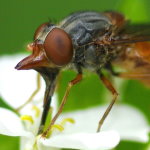Phylum Arthropoda (Arthropods) ➔ Subphylum Hexapoda (Hexapods) ➔ Class Insecta (Insects) ➔ Order Diptera (True flies) ➔ Family Syrphidae (Hoverflies)
Rhingia rostrata (Linnaeus, 1758)
Synonyms and other combinations:
Rhingia rostrata Scopoli, 1763 |
Classification:
Rhingia rostrata belongs to the subfamily Eristalinae, tribe Rhingiini.Distribution:
From southern Finland and southern Sweden south to northern Spain; from Britain (Wales, southern England) eastwards through central Europe into European parts of Russia, the Caucasus and western Siberia.Habitat:
Deciduous forest and scrubs with a rich herb layer.Description:
Body length 8 - 9 mm; face forward strikingly beak-shaped extended; thorax completely gray dusted; abdomen stout, almost completely red with red side seam; legs almost completely red.Similar species:
In Europe there are two other species of the genus: Rhingia campestris with an abdomen with black side seam and mostly black margins of the abdominal tergits and Rhingia borealis with black femora which can be slightly lighter at the tip, a dark brown scutellum and a slightly shorter "beak".Biology:
Rhingia rostrata flies in two generations from the beginning of May to July and from mid of August to the beginning of October. Adults live in woodland, settle on foliage of large-leaved plants, e.g. Arctium, and visit flowering plants in small glades. Known nectar and pollen sources are Centaurea, Cirsium, Geranium robertianum, Hypericum, Succisa and Veronica.The females of Rhingia rostrata lay their eggs on the underside of the leaves of trees where there is dung of large mammals, usually ungulates, on the ground below. After 5 to 6 days, the young larvae hatch and drop onto the dung. Approximately 2 weeks later the larvae are fully grown and pupate in the soil.
Larvae of Rhingia rostrata were found in horse dung.
References, further reading, links:
- Pape T. & Thompson F.C. (eds) (2017). Systema Dipterorum (version 2.0, Jan 2011). In: Species 2000 & ITIS Catalogue of Life, 2017 Annual Checklist (Roskov Y., Abucay L., Orrell T., Nicolson D., Bailly N., Kirk P.M., Bourgoin T., DeWalt R.E., Decock W., De Wever A., Nieukerken E. van, Zarucchi J., Penev L., eds.). Digital resource at www.catalogueoflife.org/annual-checklist/2017. Species 2000: Naturalis, Leiden, the Netherlands. ISSN 2405-884X.
- Gerald Bothe: Bestimmungsschlüssel für die Schwebfliegen (Diptera, Syrphidae) Deutschlands und der Niederlande, DJN, 1984, ISBN 3-923376-07-3
- M.C.D.Speight: Species Accounts of European Syrphidae (Diptera), Glasgow 2011, Syrph the Net, the database of European Syrphidae, vol. 65, 285 pp., Syrph the Net publications, Dublin.
- Menno Reemer, Willem Renema, Wouter van Steenis, Theo Zeegers, Aat Barendregt, John T. Smit, Mark P. van Veen, Jeroen van Steenis, Laurens van der Leij: De Nederlandse Zweefvliegen (Diptera: Syrphidae), Nederlandse Fauna 8, 2009.
- Anasimyia interpuncta
- Anasimyia transfuga
- Baccha elongata
- Brachyopa sp.
- Brachypalpoides lentus
- Brachypalpus laphriformis
- Brachypalpus sp.
- Brachypalpus valgus
- Ceriana conopsoides
- Ceriana vespiformis
- Chalcosyrphus femoratus
- Chalcosyrphus valgus
- Cheilosia albipila
- Cheilosia albitarsis
- Cheilosia chrysocoma
- Cheilosia illustrata
- Cheilosia pagana
- Cheilosia scutellata
- Cheilosia sp.
- Chrysogaster sp.
- Chrysotoxum bicinctum
- Chrysotoxum fasciatum
- Chrysotoxum festivum
- Chrysotoxum verralli
- Criorhina berberina
- Dasysyrphus albostriatus
- Dasysyrphus sp.
- Dasysyrphus tricinctus
- Didea fasciata
- Didea intermedia
- Didea sp.
- Epistrophe diaphana
- Epistrophe eligans
- Epistrophe flava
- Epistrophe melanostoma
- Epistrophe melanostoma/nitidicollis
- Epistrophella euchroma
- Eristalinus megacephalus
- Eristalis interrupta
- Eristalis intricaria
- Eristalis lineata
- Eristalis rupium
- Eristalis similis
- Eristalis sp.
- Eumerus purpurariae
- Eumerus sp.
- Eupeodes luniger
- Eupeodes sp.
- Ferdinandea cuprea
- Helophilus hybridus
- Helophilus sp.
- Helophilus trivittatus
- Ischiodon aegyptius
- Leucozona glaucia
- Leucozona laternaria
- Leucozona lucorum
- Melangyna lasiophthalma
- Melangyna quadrimaculata
- Melangyna umbellatarum
- Melanogaster sp.
- Meligramma triangulifera
- Meliscaeva cinctella
- Merodon ambiguus
- Merodon avidus
- Merodon moenium
- Merodon obscuritarsis
- Merodon sp.
- Microdon analis/major
- Microdon mutabilis/myrmicae
- Myolepta dubia
- Orthonevra sp.
- Paragus sp.
- Parasyrphus lineolus
- Parhelophilus sp.
- Pipiza austriaca
- Pipiza bimaculata
- Pipiza fenestrata
- Pipiza sp.
- Platycheirus rosarum
- Platycheirus sp.
- Rhingia rostrata
- Scaeva albomaculata
- Scaeva selenitica
- Sericomyia lappona
- Sphaerophoria rueppelli
- Sphaerophoria sp.
- Sphegina sp.
- Spilomyia saltuum
- Syrphus sp.
- Syrphus vitripennis
- Temnostoma bombylans
- Temnostoma meridionale
- Temnostoma vespiforme
- Tropidia scita
- Xanthogramma citrofasciatum
- Xanthogramma pedissequum
- Xylota sp.
- Xylota sylvarum
- Aspen Hoverfly
- Band-eyed Drone Fly
- Black-horned Smoothtail
- Brown-toed Forest Fly
- Bumblebee Hoverfly
- Chequered Hoverfly
- Common Bog Hoverfly
- Common Drone Fly
- Common Snout-hoverfly
- Deadhead Hover Fly
- Dusky-banded Forest Fly
- European Drone Fly
- Figwort Cheilosia
- Four-spotted Pipiza
- Hornet Mimic Hoverfly
- Large Hoverfly
- Large Narcissus Fly
- Larger Spotty-eyed Drone Fly
- Long Hoverfly
- Marmalade Fly
- Migrant Hoverfly
- Orange-belted Plumehorn
- Pied Hoverfly
- Pine Hoverfly
- Snouted Duckfly
- Summer Fly
- Sun Fly
- Tapered Drone Fly
- Thick legged Hoverfly
- White-banded Drone Fly


